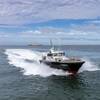Wärtsilä Launches WTT-40 Transverse Thruster
Wärtsilä is launching its new Wärtsilä WTT-40 transverse thruster.
The first WTT-40's have been ordered and are scheduled for delivery during 2016. This first variant is part of Wärtsilä's new transverse thruster series and features a 4000 kW power level and a 3400 mm diameter controllable pitch propeller, neither of which have been available in Wärtsilä's current product range. While Wärtsilä has designed and built large, up to 5500 kW, transverse thrusters as customised versions, the WTT-40 and others in the WTT range address customer needs for high power transverse thrusters for bow and stern applications.
Development work on the Wärtsilä WTT-40 began in 2015 in response to market demand. It is intended for various vessel types, notably cruise ships, large offshore support vessels (OSVs) and offshore construction vessels (OCVs). The high power level is particularly important for the harbour manoeuvring and docking of large ships, and for dynamic positioning of offshore vessels working in heavy sea conditions.
Because of its maximum power of 4000 kW, shipyards and cruise vessel designers can often utilise three WTT-40 thrusters instead of four smaller ones. This creates a more efficient vessel design with less space required for the transverse thrusters. It also allows them to be located closer to the bow where they are more effective. For the WTT-40 and other sizes of thruster in the WTT series, configurations with controllable pitch and fixed pitch propellers are available to fulfil a broad range of vessel design requirements. Wärtsilä's extensive experience with propeller design and tunnel optimizations using computational fluid dynamics (CFD) analysis, ensures an optimal solution when it comes to propulsion performance, efficiency, and the minimisation of noise and vibration.
The Wärtsilä WTT-40 is able to comply with the US EPA's (Environmental Protection Agency) VGP2013 regulations. These state that environmentally acceptable lubricants (EALs) must be used in all oil-to-sea interfaces, such as the propeller shaft seal of transverse thrusters, when vessels are sailing in US coastal waters.
The new thruster also features integrated hydraulics to save machinery room space and installation and commissioning time in the shipyard. For owners, the integrated hydraulics provide reliability and maintainability benefits thanks to the good lubrication, oil conditioning and easy access for maintenance.












